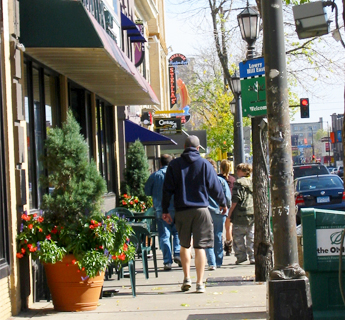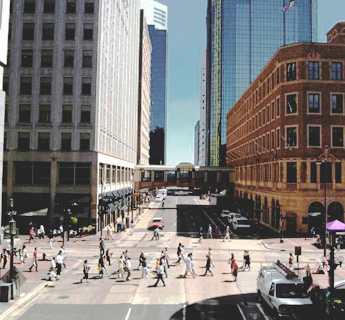Pedestrians: Improve the pedestrian environment in order to encourage walking and the use of mobility aids as a mode of transportation.


Walking and the use of mobility aids is an essential mode of transportation in Minneapolis. Everyone walks, whether young or old, whether on foot or using a mobility device, whether as a pedestrian trip alone or in conjunction with taking transit, bicycling, or driving. Pedestrians and pedestrian environments support the economy. The most successful commercial districts in Minneapolis rely on high levels of pedestrian traffic. Pedestrian activity also contributes to an active lifestyle, improving health outcomes. Increasing the number of pedestrians and improving the pedestrian environment are critical components of reducing greenhouse gas emissions, both directly and indirectly. Specific sidewalk design guidance, which is carefully planned according to accessibility standards, adjacent land uses, and street typology, is provided in the Street and Sidewalk Design Guidelines that are part of the City's Transportation Action Plan.
 ACTION STEPS
ACTION STEPS
The City will seek to accomplish the following action steps to improve the pedestrian environment in order to encourage walking and the use of mobility aids as a mode of transportation.
- Improve safety for pedestrians, and prioritize pedestrians over other road users, especially at street intersections; focus on signals, crosswalks, lighting, signage, visibility and lowering vehicular speeds through street design and other measures.
- Foster vibrant public spaces for street life.
- Provide clearly-designated pedestrian areas in accordance with the City's Street and Sidewalk Design Guidelines.
- Minimize the number of vehicle curb cuts that hinder pedestrian safety; be deliberate in the placement of drop-off zones and other curb side uses and evaluate the pedestrian benefits as a part of the decision-making process.
- Deploy traffic calming measures.
- Improve pedestrian connections across barriers such as freeways, highways, and busy streets.
- Encourage sidewalk widths that reflect existing or expected volumes of pedestrian traffic, as guided in Street and Sidewalk Design Guidelines.
- As opportunities exist, encourage and design for streetscape amenities, including street furniture, street lighting, trees, and landscaping, that buffer pedestrians from street traffic and parking areas.
- Continue to make improvements to the existing sidewalk network, and fill existing sidewalk gaps.
- Implement and expand zoning regulations and incentives that promote pedestrian activity, such as the provision of secured storage for transportation carts near building entrances, storage lockers, and changing and shower facilities.
- Ensure timely city-wide enforcement of regulations for snow and ice removal from sidewalks. Include annual public education and support for those with physical limitations. Explore additional strategies, technologies, and improved City clearance operations.

